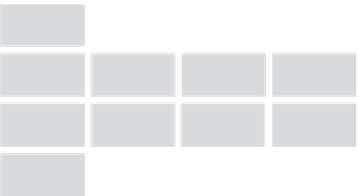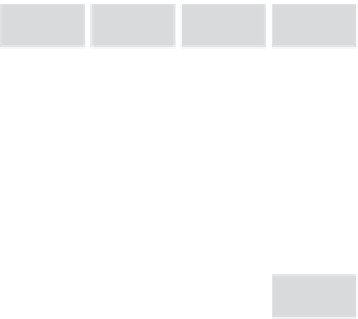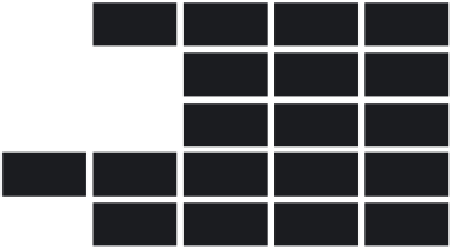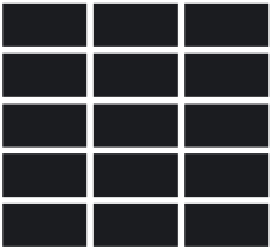Graphics Reference
In-Depth Information
12-17
This morphology features a collection of
typographic factors that can be freely appropriated
in the course of solving typographic problems. The
challenge and joy of using a morphology is to combine
the components of the various categories in a search
for visual alternatives.
The boxes filled with black represent other possibilities
that may be added as needed.
Typographic factors
1. 1
case
1. 1. 1
upper
1. 1. 2
lower
1. 1. 3
combination
Morphologies.
A morphology is a
menu of visual possibilities. It consists of a
list of syntactic and/or semantic variables
that can be systematically or randomly
explored in a search for typographic solutions
(Fig.
12-17
). Morphologies can be tailored
in size and scope to accommodate a wide
range of problems and applications. Just
as the twenty-six letters of the alphabet
are combined to form an infinite number
of words, so too can morphological factors
be employed to achieve a vast number of
typographic effects. When used freely and
creatively, morphologies liberate rather
than constrain the creative mind. Several
precedents exist for the development and
use of morphologies in typographic design
practice, including the pioneering work
of Karl Gerstner, who developed logical
morphologies based on the formal language
of type. Gerstner believes that working with
“morphological boxes” enables randomness,
serendipity, and a kind of invention. He
wrote, “Working by the morphological
method is value-free and unprejudiced—
and at least makes it easier to find pioneer
solutions where they are possible.”
1. 2
face
1.2.1
serif
1.2.2
sans serif
1.2.3
script
1.2.4
decorative
1.2.5
combination
1. 3
size
1.3.1
small
1.3.2
medium
1.3.3
large
1.3.4
combination
1.4.1
slight
1.4.2
medium
1.4.3
extreme
1.4.4
combination
1. 4
slant
1. 5
weight
1.5.1
light
1.6.1
narrow
1.5.3
heavy
1.6.3
wide
1.5.2
medium
1.6.2
medium
1.5.4
combination
1.6.4
combination
1. 6
width
Form factors
2.1
blending
2.1.1
linear
2.1.2
radial
2.1.3
combination
2.2
distortion
2.2.1
fragmenting
2.2.2
skewing
2.2.3
bending
2.2.4
stretching
2.2.5
blurring
2.2.6
inverting
2.2.7
mutilating
2.2.8
combination
2.3
elaboration
2.3.1
addition
2.3.2
subtraction
2.3.3
extension
2.3.4
combination
2.4
outline
2.4.1
thin
2.4.2
medium
2.4.3
thick
2.4.4
broken
2.4.5
combination
2.5.1
fine
2.5.2
coarse
2.5.3
regular
2.5.4
irregular
2.5.5
combination
2.5
texture
2.6
dimensionality
2.6.1
volumetric
2.6.2
shadowing
2.6.3
combination
2.7
tonality
2.7.1
light
2.7.2
medium
2.7.3
dark
2.7.4
combination
Space factors
3.1
balance
3.1.1
symmetrical
3.1.2
asymmetrical
3.1.3
combination
3.2
direction
3.2.1
horizontal
3.2.2
vertical
3.2.3
diagonal
3.2.4
circular
3.2.5
combination
3.3
ground
3.3.1
advancing
3.3.2
receding
3.3.3
combination
3.4.3
combination
3.4
grouping
3.4.1
consonant
3.4.2
dissonant
3.5
proximity
3.5.1
overlapping
3.5.2
touching
3.5.3
separating
3.5.4
combination
3.6
repetition
3.6.1
few
3.7.1
regular
3.6.2
many
3.6.3
random
3.7.3
alternating
3.6.4
pattern
3.6.5
combination
3.7
rhythm
3.7.2
irregular
3.7.4
progressive
3.7.5
combination
3.8
rotation
3.8.1
slight
3.8.2
moderate
3.8.3
extreme
3.8.4
combination
Support factors
4.1
ruled lines
4.1.1
horizontal
4.1.2
vertical
4.1.3
diagonal
4.1.4
curved
4.1.5
stair-stepped
4.2.5
combination
4.1.6
thin
4.1.7
medium
4.1.8
thick
4.2
shapes
4.2.1
geometric
4.2.2
organic
4.2.3
background
4.2.4
adjacent
4.3
symbols
4.3.1
normal
4.3.2
manipulated
4.3.3
combination
4.4
images
4.4.1
background
4.4.2
adjacent
4.4.3
contained
4.4.4
manipulated
4.4.5
combination


























































